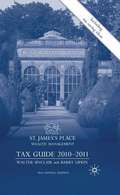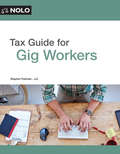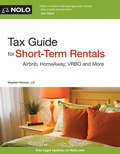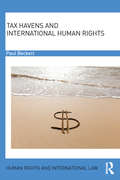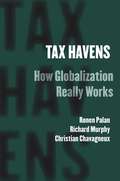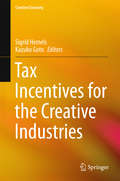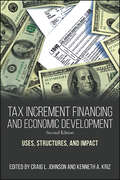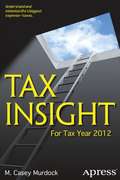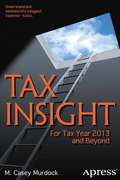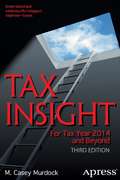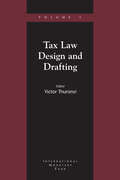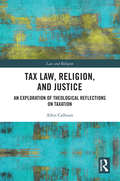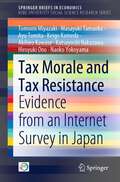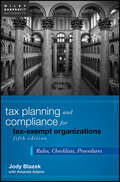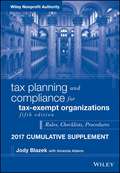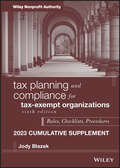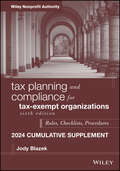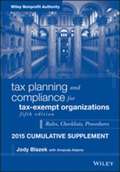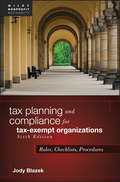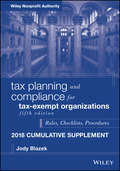- Table View
- List View
Tax Guide 2010–2011
by Walter Sinclair Barry LipkinThe 39th annual edition of the leading guide to taxation in Britain. This practical and user-friendly guide is a bestseller with students, professionals, accountants and private individuals, explaining in simple terms how the UK tax system works and how best to minimise tax liabilities.
Tax Guide 2011–2012
by Walter SinclairThe 40th annual edition of the leading guide to taxation in Britain. This practical and user-friendly guide is a bestseller with students, professionals, accountants and private individuals; explaining in simple terms how the UK tax system works and how best to minimise tax liabilities.
Tax Guide 2012–2013
by Barry LipkinThe 41st annual edition of the leading guide to taxation in Britain. This practical and user-friendly guide is a bestseller with students, professionals, accountants and private individuals, explaining in simple terms how the UK tax system works and how best to minimise tax liabilities.
Tax Guide 2014–2015
by Walter Sinclair Barry LipkinThe 43rd annual edition of the leading guide to taxation in Britain. This practical and user-friendly guide is a bestseller with students, professionals, accountants and private individuals, explaining in simple terms how the UK tax system works and how best to minimise tax liabilities.
Tax Guide for Gig Workers
by Stephen FishmanWritten for the growing numbers of freelancers who are part of the burgeoning gig economy. At least 10% of the American workforce are now gig workers who obtain jobs through online hiring platforms like Uber, Lyft, Upwork, TaskRabbit and many others. Gig workers are typically treated as self-employed, which means their taxes are far more complicated than those of traditional employees. Many gig workers lose valuable deductions or otherwise overpay their taxes or get in trouble with the IRS because they don’t understand the tax rules that apply to them. Tax Guide for Gig Workers explains everything gig workers need to know about taxes, including how they are classified for tax purposes, how to pay self-employment and estimated taxes, what deductions to take, how to lower their taxes by taking advantage of the new 20% pass-through deduction, what records to keep, how to file a tax return, and more. Whether you drive for Uber or Lyft, code for Upwork clients, or perform paid chores through TaskRabbit, this book gives you the practical information you need to minimize your taxes while avoiding problems with the IRS.
Tax Guide for Short-Term Rentals: Airbnb, HomeAway, VRBO and More
by Stephen FishmanThe complete tax guide for Airbnb and other short-term rental hosts As a short-term rental host, you’re entitled to many valuable deductions and other tax benefits. This book—the first of its kind—shows you how to pay no more tax than necessary on your rental income while complying with IRS rules. Learn everything you need to know about taxes, including: what deductions you should be taking how to report your short-term rental income how to deduct losses vacation home and tax-free rental rules how to allocate costs when you rent a room in your home, and how to keep proper records. Whether you rent your property through Airbnb, FlipKey, HomeAway, TripAdvisor, Craigslist, or VRBO, you want to make sure you understand these tax rules. That way, you can rest assured you are making the most out of your hosting business without risking problems with the IRS.
Tax Harmonization in the European Community
by George KopitsA report from the International Monetary Fund.
Tax Havens
by James Zumberge Eric Werker Sebastian Berardi Stelios Elia Omar MuakkassaMultinational corporations and wealthy individuals often use so-called tax havens to establish subsidiaries or holding companies in order to rebalance profits across borders with the primary purpose of lowering their effective tax rate. This note describes the use of tax havens, the implications for the financial sector in tax havens, as well as the debate around the effect of tax havens on welfare in other jurisdictions.
Tax Havens and International Human Rights (Human Rights and International Law)
by Paul BeckettThis book sails in uncharted waters. It takes a human rights-based approach to tax havens, and is a detailed analysis of structures and the laws that generate and support these. It makes plain the unscrupulous or merely indifferent ways in which, using tax havens, businesses and individuals systematically undermine and for all practical purposes eliminate access to remedies under international human rights law. It exposes as abusive of human rights a complex structural web of trusts, companies, partnerships, foundations, nominees and fiduciaries; secrecy, immunity and smoke screens. It also lays bare the cynical manipulation by tax havens of traditional legal forms and conventions, and the creation of entities so bizarre and chimeric that they defy classification. Yet from the perspective of the tax havens themselves, these are entirely legitimate; the product of duly enacted domestic laws. This book is not a work of investigative journalism in the style of the Pulitzer Prize-winning authors of The Panama Papers, exposing political or financial corruption, money laundering or the financing of terrorism. All those elements are present of course, but the focus is on international human rights and how tax havens do not merely facilitate but actively connive at their breach. The tax havens are compromising the international human rights legal continuum.
Tax Havens: How Globalization Really Works (Cornell Studies in Money)
by Richard Murphy Ronen Palan Christian ChavagneuxFrom the Cayman Islands and the Isle of Man to the Principality of Liechtenstein and the state of Delaware, tax havens offer lower tax rates, less stringent regulations and enforcement, and promises of strict secrecy to individuals and corporations alike. In recent years government regulators, hoping to remedy economic crisis by diverting capital from hidden channels back into taxable view, have undertaken sustained and serious efforts to force tax havens into compliance. In Tax Havens, Ronen Palan, Richard Murphy, and Christian Chavagneux provide an up-to-date evaluation of the role and function of tax havens in the global financial system-their history, inner workings, impact, extent, and enforcement. They make clear that while, individually, tax havens may appear insignificant, together they have a major impact on the global economy. Holding up to $13 trillion of personal wealth-the equivalent of the annual U. S. Gross National Product-and serving as the legal home of two million corporate entities and half of all international lending banks, tax havens also skew the distribution of globalization's costs and benefits to the detriment of developing economies. The first comprehensive account of these entities, this book challenges much of the conventional wisdom about tax havens. The authors reveal that, rather than operating at the margins of the world economy, tax havens are integral to it. More than simple conduits for tax avoidance and evasion, tax havens actually belong to the broad world of finance, to the business of managing the monetary resources of individuals, organizations, and countries. They have become among the most powerful instruments of globalization, one of the principal causes of global financial instability, and one of the large political issues of our times.
Tax Incentives for the Creative Industries
by Sigrid Hemels Kazuko GotoThis book combines insights from cultural economics, public finance, and tax law, providing an accessible and comprehensive introduction in the application of tax incentives for the creative industries. It does not have a single-country focus, but instead uses the perspective and examples of various countries around the world. The book starts with a theoretical part, introducing the concepts of creative industries and of tax incentives. In the globalized and digitalized world in which the creative industries operate, restrictions imposed by guidelines on harmful tax competition and state aid and regulations influencing the (im)possibility of applying tax incentives in cross-border situations have a great impact. For that reason these legal concepts are discussed as well in the theoretical part. The theoretical part is followed by a part that focuses on tax incentives for specific sectors of the creative industries, inter alia museums and cultural heritage, films, television and videogames, cultural investments, performing artists, and crafts and design. This part uses insightful examples from various countries to illustrate the application of these tax incentives. The last part includes policy recommendations on how tax incentives can be applied in an effective and efficient way for the creative industries. As the book takes both an academic and a practical approach, it is of relevance both to researchers and students and to policy makers and readers involved in the creative industry who seek an in-depth and up-to-date overview of this alternative way in which governments support the creative industries.
Tax Increment Financing and Economic Development, Second Edition: Uses, Structures, and Impact
by Craig L. Johnson; Kenneth A. KrizThis book brings together leading experts to examine the evolving nature of tax increment financing (TIF), the most widely used tool of local economic and community development. Originally designed as an innovative approach to the redevelopment of blighted areas, it has become a more general-purpose tool of economic and community development. Contributors offer case studies of the uses, structures, and impacts of TIF projects alongside more general discussions on the theoretical, financial, and legal bases for the use of TIF. They also explore its effect on overlapping jurisdictions such as cities, counties, and school districts. Some of the case studies capture TIF at its best—redeveloping areas that would likely never develop without substantial incentives. Other cases highlight questionable uses, especially where it has been used in new ways that those who developed the tool never envisioned.Originally published in 2001, the book was called "…a major contribution to the debate on the efficacy of such economic development financing tools as TIF…" by the journal Public Budgeting & Finance. Clear, comprehensive, and timely, this new edition features the latest research and thinking on TIF, including the political, legal, and even ethical issues surrounding its use.
Tax Insight
by M. Casey MurdockTax Insight: For Tax Year 2012 will teach you to take control of life''s biggest expense--taxes. In your lifetime, you will spend more money on taxes than on anything else. Despite that fact, you likely know the current prices of movies and milk but don''t know what your marginal tax rate is. You know where to get the cheapest gallon of gas to save a buck or two, but you don''t give a thought to the tax strategies you should be using right now that would save you thousands. Why? Is it too complicated and confusing? Too unpleasant? In Tax Insight, tax expert Casey Murdock opens up the world of taxes with amazing clarity and simplicity. As you will discover, you have within reach numerous ways to reduce your taxes. With everyday language and real-life examples, Tax Insight will give you the keys to minimizing your tax burden. This book contains information you need even if you have a tax advisor or use a program like TurboTax. Tax professionals are busy and sometimes too cautious, and programs often miss opportunities for you to save money. It''s also for those of all ages and income levels, including business owners. Tax Insight: Breaks down the key components of taxes with ease and simplicity. Provides a roadmap to paying as little tax as possible. Helps you know if you should do it yourself or hire a professional. While there are many encyclopedic books on taxes--like J. K. Lasser''s Your Taxes--there aren''t nearly enough that describe the tax code in plain language. Far more than a rehash of impenetrable IRS "help" documents, Tax Insights is organized the way most people think and presents ideas in clear, simple language. If you buy this book and take advantage of its advice, you will save money. What you''ll learn This book will help you: Avoid paying even a penny more in taxes than you should. Avoid common tax strategies that could actually cost you more than they save. Capture all of the deductions and credits that you are due. Know whether to file your own return or hire a tax professional. Utilize the entire year to implement tax-reducing strategies. Understand the key components of the tax return and how they work together. Prepare for or survive an audit Use real estate or a small business to reduce your tax bill Who this book is for Tax Insight: For Tax Year 2012 is for the frustrated taxpayer--the taxpayer who is frustrated by paying too much, frustrated by the complexity of the tax code, or frustrated because their CPA isn''t proactively helping them pay fewer taxes. Tax Insight is the perfect book for the person who is looking for a straightforward, simple explanation of the tax-saving strategies that are within reach. In an easy-to-read, easy-to-understand narrative, Tax Insight gives readers a thorough understanding of the tax strategies that apply to them and the information they need to put those strategies to work. Table of Contents The Tax Code Demystified Key Components Defined Income Dependents and Filing Status The Tax Code Is Rigged Employment Income Retirement Income Other Sources of Ordinary Income Tax-Free "Unordinary" Income from Non-Investment Sources Tax-Free Investment Income Taxable Investment Income Deductions from Investment Income Education Investment Strategies Retirement Investment Strategies--The Basics Retirement Investment Strategies--Alternatives Business Taxation Business Use of the Home Travel Expenses Meals, Entertainment, and Gifts Employee Benefits Employing Family Members Depreciation Real Estate Losses Real Estate Income and Deductions Second Homes and Vacation Rentals Medical and Dental Expenses Your Residence Your Children Charitable Contributions Education Expenses The Alternative Minimum Tax Penalties and Interest Do It Yourself, or Hire a Professional? Tax Implications of Health Care Reform
Tax Insight: For Tax Year 2013 and Beyond
by M. Casey MurdockTax Insight: For Tax Year 2013 and Beyond will teach you to take control of life’s biggest expense—taxes. In your lifetime, you will spend more money on taxes than on anything else. Despite that fact, you likely know the current prices of movies and milk but don’t know what your marginal tax rate is. You know where to get the cheapest gallon of gas to save a buck or two, but you don’t give a thought to the tax strategies you should be using right now that would save you thousands. Why? Is it too complicated and confusing? Too unpleasant? In Tax Insight, tax expert Casey Murdock opens up the world of taxes with amazing clarity and simplicity. As you will discover, you have within reach numerous ways to reduce your taxes. With everyday language and real-life examples, Tax Insight will give you the keys to minimizing your tax burden. This book contains information you need even if you have a tax advisor or use a program like TurboTax. Tax professionals are busy and sometimes too cautious, and programs often miss opportunities for you to save money. It's also for those of all ages and income levels, including business owners. Tax Insight: Breaks down the key components of taxes with ease and simplicity. Provides a roadmap to paying as little tax as possible. Helps you know if you should do it yourself or hire a professional. While there are many encyclopedic books on taxes—like J.K. Lasser’s Your Taxes—there aren’t nearly enough that describe the tax code in plain language. Far more than a rehash of impenetrable IRS "help" documents, Tax Insights is organized the way most people think and presents ideas in clear, simple language. If you buy this book and take advantage of its advice, you will save money. What you’ll learn This book will help you: Avoid paying even a penny more in taxes than you should. Avoid common tax strategies that could actually cost you more than they save. Capture all of the deductions and credits that you are due. Know whether to file your own return or hire a tax professional. Utilize the entire year to implement tax-reducing strategies. Understand the key components of the tax return and how they work together. Prepare for or survive an audit Use real estate or a small business to reduce your tax bill Who this book is for Tax Insight: For Tax Year 2013 and Beyond is for the frustrated taxpayer—the taxpayer who is frustrated by paying too much, frustrated by the complexity of the tax code, or frustrated because their CPA isn’t proactively helping them pay fewer taxes. Tax Insight is the perfect book for the person who is looking for a straightforward, simple explanation of the tax-saving strategies that are within reach. In an easy-to-read, easy-to-understand narrative, Tax Insight gives readers a thorough understanding of the tax strategies that apply to them and the information they need to put those strategies to work.
Tax Insight: For Tax Year 2014 and Beyond
by M. Casey MurdockTax Insight: For Tax Year 2014 and Beyond will teach you to take control of life’s biggest expense—taxes. In your lifetime, you will spend more money on taxes than on anything else. Despite that fact, you likely know the current prices of movies and milk but don’t know what your marginal tax rate is. You know where to get the cheapest gallon of gas to save a buck or two, but you don’t give a thought to the tax strategies you should be using right now that would save you thousands. It's not hard to understand why--taxes are complicated, unpleasant, and confusing. In Tax Insight, tax expert Casey Murdock opens up the world of taxes with amazing clarity and simplicity. As you will discover, you have within reach numerous ways to reduce your taxes. With everyday language and real-life examples, Tax Insight will give you the keys to minimizing your tax burden. This book contains information you need even if you have a tax advisor or use a program like TurboTax. Tax professionals are busy and sometimes too cautious, and programs often miss opportunities for you to save money. It's also for those of all ages and income levels, including business owners. Tax Insight: Breaks down the key components of taxes with ease and simplicity. Provides a roadmap to paying as little tax as possible. Helps you know if you should do it yourself or hire a professional. While there are many encyclopedic books on taxes—like J.K. Lasser’s Your Taxes—there aren’t nearly enough that describe the tax code in plain language. Far more than a rehash of impenetrable IRS "help" documents, Tax Insight is organized the way most people think and presents ideas in clear, simple language. If you buy this book and take advantage of its advice, you will save money. What you’ll learn This book will help you: Avoid paying even a penny more in taxes than you should. Avoid common tax strategies that could actually cost you more than they save. Capture all of the deductions and credits that you are due. Know whether to file your own return or hire a tax professional. Utilize the entire year to implement tax-reducing strategies. Understand the key components of the tax return and how they work together. Prepare for or survive an audit Use real estate or a small business to reduce your tax bill Who this book is for Pay Less Tax: For Tax Year 2014 and Beyond is for the frustrated taxpayer—the taxpayer who is frustrated by paying too much, frustrated by the complexity of the tax code, or frustrated because their CPA isn’t proactively helping them pay fewer taxes. Pay Less Tax is the perfect book for the person who is looking for a straightforward, simple explanation of the tax-saving strategies that are within reach. In an easy-to-read, easy-to-understand narrative, Pay Less Tax gives readers a thorough understanding of the tax strategies that apply to them and the information they need to put those strategies to work.
Tax Law Design and Drafting, Volume 1: [subtitle]
by Victor T ThuronyiA report from the International Monetary Fund.
Tax Law, Religion, and Justice: An Exploration of Theological Reflections on Taxation (Law and Religion)
by Allen CalhounThis book asks why tax policy is both attracted to and repelled by the idea of justice. Accepting the invitation of economist Henry Simons to acknowledge that tax justice is a theological concept, the work explores theological doctrines of taxation to answer the presenting question. The overall message of the book is that taxation is an instrument of justice, but only when taxes take into account multiple goods in society: the requirements of the government, the property rights of society’s members, and the material needs of the poor. It is argued that this answer to the presenting question is a theological and ethical answer in that it derives from the insistence of Christian thinkers that tax policy take into account material human need (necessitas). Without the necessitas component of the tax balance, tax systems end up honoring only one of the three components of the tax equation and cease to reflect a coherent idea of justice. The book will be of interest to academics and researchers working in the areas of tax law, economics, theology, and history.
Tax Morale and Tax Resistance: Evidence from an Internet Survey in Japan (SpringerBriefs in Economics)
by Keigo Kameda Tomomi Miyazaki Masayuki Tamaoka Ayu Tomita Akihiro Kawase Katsuyoshi Nakazawa Hiroyuki Ono Naoko YokoyamaThis book is the first to shed light on the recent opinion of taxpayers on tax and fiscal policy in Japan through an attitude questionnaire. It is said that Japanese taxpayers’ tax morale is high. However, taxpayers in Japan are often described as having strong resistance to tax increases, especially consumption tax increases. There is, then, a paradox with respect to the attitude toward tax policies among Japanese citizens. This book provides background information and basic descriptive statistics from Internet surveys in Japan by the authors, who introduce their results by focusing on tax morale and opinions with respect to a consumption tax hike. The summary statistics indicate that while tax morale is high, half of the respondents oppose a consumption tax hike from 8% to 10%. Furthermore, the ideal consumption tax rate for most respondents was less than 10% in both surveys, suggesting that Japanese taxpayers have a strong tax resistance, attributable to distrust of government and politicians.
Tax Planning and Compliance for Tax-Exempt Organizations
by Jody Blazek Amanda AdamsAn essential, timesaving guide for accountants, lawyers, nonprofit executives and directors, consultants, and volunteersThis book is an indispensable guide to navigating the complex maze of nonprofit tax rules and regulations. A clear and fully cited description of the requirements for the various categories of tax-exempt entities from public charities, private foundations, civic associations, business leagues, and social clubs to title-holding companies and governmental entities can be found. Practical guidance on potential for income tax on revenue-producing enterprises along with explanations of many exceptions to taxability is provided. Issues raised by Internet activity, advertising, publishing, providing services, and much more are explained.This useful guide covers the many significant issues facing nonprofit organizations, including compensation and possible private inurement, affiliation, separations and mergers, donor disclosures, lobbying and electioneering, and employment taxes.Offers a supplemental, annual update to keep subscribers current on relevant changes in IRS forms, requirements, and related tax proceduresIncludes easy-to-use checklists highlighting such critical concerns as tax-exempt eligibility, reporting to the IRS, and comprehensive tax compliance issuesFeatures a variety of sample documents for private foundations, including penalty abatement requests and sharing space agreementsProvides helpful practice aids, such as a comparison of the differences between public and private charities, charts reflecting lobbying limits for different types of entities, and listings of rulings and cases that illustrate permissible activity for each type of organizations compared to impermissible activityFilled with practical tips and suggestions for handling such critical situations as preparing for and surviving an IRS examination, Tax Planning and Compliance for Tax-Exempt Organizations, Fifth Edition provides guidance for the significant issues facing nonprofit organizations.
Tax Planning and Compliance for Tax-Exempt Organizations 2016 Cumulative Supplement
by Jody Blazek Amanda AdamsAn essential, timesaving guide for accountants, lawyers, nonprofit executives and directors, consultants, and volunteers, the Tax Planning and Compliance for Tax-Exempt Organizations: Rules, Checklists, and Procedures, Fifth Edition is an indispensable guide to navigating the complex maze of nonprofit tax rules and regulations. Along with clear, concise instructions for filing Forms 990 and other important IRS forms and documents, this practical guide covers the significant issues facing nonprofit organizations, including unrelated business income, private inurement, affiliations, and employment taxes. It also provides practical guidance on obtaining the tax exemption; reporting to boards, auditors, and the IRS; testing ongoing tax compliance; and managing lobbying expenditure.
Tax Planning and Compliance for Tax-Exempt Organizations, 2023 Cumulative Supplement: 2016 Cumulative Supplement (Wiley Nonprofit Authority Ser. #239)
by Jody BlazekAn essential, timesaving guide for accountants, lawyers, nonprofit executives and directors, consultants, and volunteers – Completely updated for 2023 This book is an indispensable guide to navigating the complex maze of nonprofit tax rules and regulations. A clear and fully cited description of the requirements for the various categories of tax-exempt entities from public charities, private foundations, civic associations, business leagues, and social clubs to title-holding companies and governmental entities can be found. Practical guidance on potential for income tax on revenue-producing enterprises along with explanations of many exceptions to taxability is provided. Issues raised by Internet activity, advertising, publishing, providing services, and much more are explained. This useful annual supplement for 2023 will cover any and all changes and updates to the law within the previous 12 month period and will keep accountants, attorneys, and others up-to-date for the year ahead. Features a variety of sample documents for private foundations, including penalty abatement requests and sharing space agreements Provides helpful practice aids, such as a comparison of the differences between public and private charities, charts reflecting lobbying limits for different types of entities, and listings of rulings and cases that illustrate permissible activity for each type of organizations compared to impermissible activity
Tax Planning and Compliance for Tax-Exempt Organizations, 2024 Cumulative Supplement: 2016 Cumulative Supplement (Wiley Nonprofit Authority Ser. #239)
by Jody Blazek Jane M. SearingAn essential resource for the legal and finance professionals serving US-based tax-exempt organizations In the 2024 Cumulative Supplement to the latest edition of Tax Planning and Compliance for Tax-Exempt Organizations, a team of dedicated legal and accounting professionals delivers a timely and current discussion of the latest rules, pronouncements, legislation, and regulations affecting tax-exempt entities. In this Supplement, you'll discover clear and fully cited and supported descriptions of the requirements for a variety of categories of tax-exempt organizations, including public charities, private foundations, civic associations, business leagues, and social clubs. In this update, you'll find: Coverage of every relevant and significant change to the taxation law governing tax-exempt organizations Various sample documents and practice aids to save time and energy in the preparation of this year's financial documents Practical guidance on the potential for income tax on revenue-producing enterprises Perfect for accountants, lawyers, executives, directors, and volunteers serving one of the many tax-exempt entities in the United States, Tax Planning and Compliance for Tax-Exempt Organizations: 2024 Cumulative Supplement is also an essential resource for consultants, managers, and other professionals working in or for tax-exempt organizations.
Tax Planning and Compliance for Tax-Exempt Organizations, Fifth Edition 2015 Cumulative Supplement
by Jody BlazekThe essential nonprofit tax guide, updated with the latest rules and requirements The 2015 Cumulative Supplement to Tax Planning and Compliance for Tax-Exempt Organizations is the latest addition to the indispensable guide to navigating nonprofit tax issues stemming from evolving regulations and IRS procedures. This most recent supplement is packed with checklists and examples that ease the filing process. This new supplement is updated to align with the relevant changes in IRS forms, requirements, and procedures to help you ensure full compliance with the most up-to-date regulations. Clear, concise instructions guide you through important forms and documents, and expert discussion provides insight on specific issues such as unrelated business income, private inurement, affiliations, and employment taxes. Helpful checklists highlight critical concerns, sample documents provide clarification and example, and the nonprofit-specific guidance leads you through obtaining tax exemption, reporting, compliance testing, and lobbying expenditure management. Nonprofit organizations contend with the possibility of losing their tax-exempt status on a daily basis. Qualification, application, maintenance, and management--every aspect of that vital status requires a solidly executed strategy for ensuring compliance with federal, state, and local regulations. The 2015 Cumulative Supplement helps you put your strategy into action, with a host of valuable tools and expert guidance on the practical aspect of nonprofit tax planning. Follow line-by-line instructions for forms and applications Access easy checklists for reporting, compliance, eligibility, and more Examine sample bylaws, applications, and forms Utilize comparison charts and other visual aids for easy reference Review bullet lists that compare what is and what is not acceptable Tax rules and regulations change annually, and nonprofit organizations know that staying compliant means staying up to date. Wading through tax code is less than helpful in the field where clear, practically oriented instruction provides the quick reference accountants, lawyers, and executives need. The 2015 Cumulative Supplement to Tax Planning and Compliance for Tax-Exempt Organizations is the essential, time-saving guide to the latest in nonprofit tax rules, regulations, and procedures.
Tax Planning and Compliance for Tax-Exempt Organizations: Rules, Checklists, Procedures (Wiley Nonprofit Authority #239)
by Jody BlazekA practical guide to handling the challenges facing tax-exempt organizations, written by a leading authority Tax Planning and Compliance for Tax-Exempt Organizations, Sixth Edition ensures that you have the practical knowledge to handle critical tax situations. This book provides guidance for the significant issues facing nonprofit organizations. It’s an essential guide to navigating the complexities of nonprofit tax rules and regulations. Packed with checklists and suggestions starting with Exhibit 1.1, Organizations Reference Chart and Exhibit 1.2, Suitability for Tax-Exempt Status, this guide helps anyone that creates, advises, or manages a nonprofit organization. Now, you can better understand the requirements for various categories of tax-exempt organizations: public charities, private foundations, civic associations, business leagues, and social clubs, as well as title-holding companies and governmental entities. You’ll discover practical guidance on the issue of potentially owing income tax on revenue-producing enterprises. Clear explanations cover the many exceptions to taxability. Tax issues related to internet activity, advertising, publishing, services, and much more are all addressed in this tax planning guide designed specifically for nonprofit and tax-exempt nonprofit organizations. Use extensive quick checklists that cover tax-exempt eligibility, reporting to the IRS, and tax compliance Find detailed instructions for submitting a variety of exemption applications and tax forms See sample documents, such as organizational bylaws, letters of application, and completed IRS forms Refer to tools and practice aids, such as a comparison chart summarizing the differences between public and private charitable organizations Written by one of the leading authorities in the field, the book also delves into recent tax law changes affecting nonprofits and other tax-exempt organizations. This indispensable guide can offer direction and support if you are challenged to successfully navigate the complex maze of nonprofit tax rules and regulations.
Tax Planning and Compliance for Tax-Exempt Organizations: Rules, Checklists, Procedures - 2018 Cumulative Supplement
by Jody BlazekThe essential time-saving guide to the latest in nonprofit tax rules, regulations, and procedures Tax rules and regulations change annually, and nonprofit organizations know that staying compliant means staying up to date. But wading through tax code is less than helpful in the field, whereas the clear, practically oriented instruction inside provides the quick reference accountants, lawyers, and executives need. In the latest edition of Tax Planning and Compliance for Tax-Exempt Organizations, you'll find straightforward information on changing Unrelated Business Income (UBI) rules, joint ventures, sponsorships, deductions against UBI, preparation of IRS forms, and more. Nonprofit organizations—including health and welfare organizations, colleges and universities, private foundations, churches, libraries, museums, cultural institutions, and other smaller groups—contend daily with the possibility of losing their tax-exempt status. From qualifying and applying for that status, to maintaining and managing it, every nonprofit organization must plan and monitor ongoing procedures, activities, and forms to comply with federal, state, and local regulations. Access easy checklists for reporting, compliance, eligibility, and more Examine sample bylaws, applications, and forms Utilize comparison charts and other visual aids for easy reference Review bullet lists that compare what is and what is not acceptable Tax Planning and Compliance for Tax-Exempt Organizations is an indispensable guide to navigating the complex maze of nonprofit tax rules and regulations.
